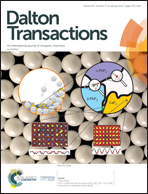Three viologen-derived Zn-organic materials: photochromism, photomodulated fluorescence, and inkless and erasable prints†
Abstract
Three zinc–viologen compounds, namely, {[Zn(Mebpy)(Hbtc)Cl]·2H2O}n (1), {[Zn3(Cebpy)2(Hbtc) (H2btc)2 (OH)2]·4H2O}n (2), and {[Zn4(Cebpy)2(IPA)3(OH)2]·2H2O}n (3) (Mebpy = N-methyl-4,4′-bipyridinium, Cebpy = N-carboxyethyl-4,4′-bipyridinium, H3btc = 1,3,5-benzenetricarboxylic acid, and H2IPA = isophthalic acid) have been constructed from aromatic carboxylic acid and viologen-derived ligands. In compound 1, the Hbtc2− ligands bridge Zn2+ cations to form a 1D fence-like chain with the Mebpy+ ligand suspended on the chains. Compound 2 possesses a 2D (4, 4) double-layered grid structure based on linear trinuclear Zn3O2 cluster units. The structure of compound 3 can be described as a 3D open-framework based on tetranuclear Zn4O2 cluster units and helical chains with helical channels. All three compounds display photochromic properties from pale yellow to dark blue after being irradiated by a xenon lamp with different photoresponsive rates. Compounds 2 and 3 can be deposited in paper simply by coating them with a solution of ethanol. The papers can be used as inkless and erasable print media. In addition, the photo-modulated luminescence of these compounds was also investigated.



 Please wait while we load your content...
Please wait while we load your content...